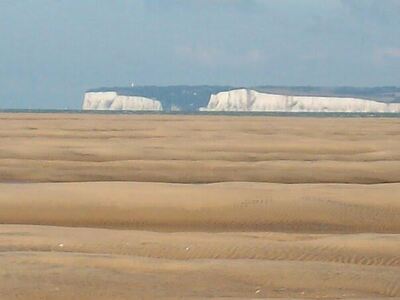The Goodwin Sands are a string of sandbanks some 25 square nautical miles in size lying 3 miles off the Kent coast in the English Channel. They are a unique marine environment with an underwater cultural heritage to match.
But this precious habitat is under threat and time is not on our side!
Dover Harbour Board want to extract 2.75 million cubic meters of marine aggregate from the Goodwins (as they are known locally) because it is their cheapest option. The purchase price from the Crown Estate who own the seabed is less than from commercial sites, but they are further away. DHB cite the carbon footprint as a reason to take the aggregate from the Goodwins but in reality this is a smoke screen which can be mitigated in other ways.
DHB applied for their licence from the Marine Management Organisation in 2016. However, concerns about their proposal have been so great that we are now preparing for an unprecedented third six-week public consultation period, which will start sometime in late summer. A decision whether or not to grant the licence will be made any time after this, depending on the reactions received.
https://www.youtube.com/watch?v=v4GrG3IdBU4
Save our Military Remains and Shipwrecks
According to the Kent Battle of Britain Museum, there are at least 60 military air crash sites and the final resting places of 80 aircrew from 1940 alone lying buried in the Goodwin Sands area. There are 11 more Dornier 17 German bombers also lying buried somewhere on the Goodwins, identical to the one which was found by a local diver in 2008 and recovered with international press coverage in 2013.
The Goodwin Sands are known hold about 2,000 shipwrecks, many which were lost with all hands. These wrecks have the reputation for being extremely well preserved. The wreck of the Admiral Gardner lies close to the proposed dredging zone. She was an East Indiaman, built in 1797, which was stranded on the sands during a gale in 1809. Although there is a 300m exclusion zone around her, the impact and vibration caused by nearby dredging could still disturb or damage her.
Four other ships - also Protected Wrecks Sites - Northumberland, Restoration, Mary and Stirling Castle were all wrecked on the night of the Great Storm, 19th November 1703, with the loss of 1201 lives. They lie on the seabed adjacent to the proposed dredging zone.
The history of Deal boatmen and the Sands are inexorably linked, giving rise to multiple tales of tragedy, lost lives and heroism. These stories of bravery are reflected in legendary characters such as Will Adams of the North Deal lifeboat, the sea going Chaplain Reverend Stanley Treanor and the sea surgeon James Hall.
A German submarine which sank off Dover after being mined in 1939 has still not been discovered. It is protected under the Protection of Military Remains Act 1986 and may well lie in or near the proposed dredging zone.
Save our Sealife
The Goodwins are home to a colony of 500 grey and harbour seals. They are also the spawning and nursery grounds of a variety of local fish and shellfish, with many shipwrecks providing a semi natural habitat. The Thornback Ray which is listed as 'near threatened' under the Wildlife and Countryside Act 1981 has frequently been sighted there.
The colony of seals use areas adjacent to the proposed dredging zone as their 'haul out' sites i.e. where they rest on land at low tide. The noise and vibration from the huge dredgers will disturb them in their natural habitat; there is also the possibility of them being injured by collision with the dredgers and propellors as they are naturally inquisitive creatures.
The sands provide shelter to ships in bad weather (in an anchorage known as The Downs) and to the Kent coastline by absorbing the waves' energy as they pound in from the North Sea. At low tide a large proportion of the sands are exposed and waves can be seen crashing onto them from the shore.
Save our Shore
The coastline between Dover and Deal is susceptible to erosion and beach recharging works are a semi permanent feature of life there. Coastal flooding along the East Kent coast is a continual problem and one which would be exacerbated by dredging the Goodwin Sands due to lowering the level and changing the topography (shape) of the sea bed. The sandbanks absorb the energy from the huge rolling waves coming in from the North Sea which would otherwise be crashing straight onto the Kent coast with destructive results.
Please help save the Goodwin Sands and their neighbouring environment from the destruction of dredging by signing and sharing this petition today.
Thank you!



